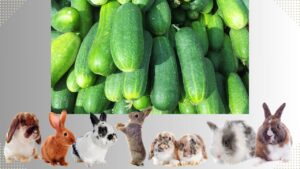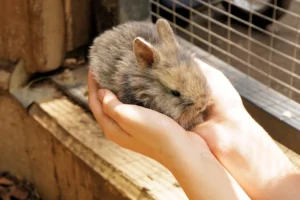Did you know that rabbits can enjoy the nutritional benefits of grape leaves? Before you introduce this leafy green into your furry friend’s diet, it’s important to understand the precautions and potential risks involved.
In this article, we will explore the dos and don’ts of feeding grape leaves to rabbits, alternative options to consider, and how to safely introduce this tasty treat.
So let’s dive in and ensure your rabbit’s diet is both healthy and delicious!
In This Article
- 1 Key Takeaways
- 2 Nutritional Benefits of Grape Leaves for Rabbits
- 3 Precautions to Take When Feeding Grape Leaves to Rabbits
- 4 How to Introduce Grape Leaves Into a Rabbit’s Diet
- 5 Potential Risks and Side Effects of Feeding Grape Leaves to Rabbits
- 6 Alternative Leafy Greens for Rabbits to Consider
- 7 Frequently Asked Questions
- 7.1 How Often Should Grape Leaves Be Included in a Rabbit’s Diet?
- 7.2 Can Rabbits Eat Grape Leaves Straight From the Vine or Do They Need to Be Washed?
- 7.3 Are There Any Specific Breeds of Rabbits That Should Not Be Fed Grape Leaves?
- 7.4 Can Rabbits With Digestive Issues or Sensitive Stomachs Safely Eat Grape Leaves?
- 7.5 Are There Any Age Restrictions for Feeding Grape Leaves to Rabbits?
- 8 Conclusion
Key Takeaways
- Grape leaves are high in fiber, which aids in maintaining a healthy digestive system for rabbits.
- They are rich in vitamins A, C, and K, which are important for overall health and the immune system of rabbits.
- Grape leaves provide essential nutrients for the well-being of rabbits and can be a tasty treat for them.
- Precautions should be taken when feeding grape leaves to rabbits, such as washing them thoroughly, monitoring for signs of toxicity, and consulting a veterinarian if adverse symptoms occur.
Nutritional Benefits of Grape Leaves for Rabbits
Did you know that grape leaves provide numerous nutritional benefits for your rabbit? These leafy greens aren’t only tasty for rabbits but also packed with essential nutrients.
One of the main benefits of feeding grape leaves to your rabbit is their high fiber content. Fiber plays a crucial role in maintaining a healthy digestive system for your furry friend. It aids in preventing digestive issues such as diarrhea and constipation.
Additionally, grape leaves are a rich source of vitamins A, C, and K, which are important for your rabbit’s overall health and immune system.
However, it’s important to note that some rabbits may have allergic reactions to grape leaves, so it’s always recommended to introduce new foods slowly and observe any adverse reactions.
Precautions to Take When Feeding Grape Leaves to Rabbits
Make sure to thoroughly wash the grape leaves and remove any stems or veins before feeding them to your rabbits, as they can be a potential choking hazard. When preparing grape leaves for rabbits, it’s important to take certain precautions to ensure the safety and well-being of your furry friends.
Firstly, rinse the leaves under cold water to remove any dirt or pesticides. Next, carefully inspect each leaf, removing any stems or veins that may pose a choking risk.
It’s also essential to monitor your rabbits for any signs of grape leaf toxicity, such as diarrhea, vomiting, or loss of appetite. If you notice any of these symptoms, immediately stop feeding grape leaves and consult your veterinarian.
How to Introduce Grape Leaves Into a Rabbit’s Diet
To introduce grape leaves into your rabbit’s diet, simply chop them into small pieces and mix them with their regular food. Grape leaves can be a nutritious addition to your rabbit’s diet, providing various benefits. They’re rich in fiber, which helps maintain a healthy digestive system and prevents issues like gastrointestinal stasis.
Additionally, grape leaves contain essential vitamins and minerals like vitamin A, vitamin K, and calcium, all of which contribute to your rabbit’s overall health. When preparing grape leaves for your rabbit, make sure to wash them thoroughly to remove any pesticides or dirt. It’s important to avoid using leaves from plants that have been treated with chemicals.
Also, ensure that the leaves are fresh and free from mold or pests. By following these steps, you can safely introduce grape leaves into your rabbit’s diet and provide them with the additional nutrients they need.
Potential Risks and Side Effects of Feeding Grape Leaves to Rabbits
Are there any potential risks or side effects you should be aware of when feeding grape leaves to your rabbits? It’s important to consider the potential toxicity and proper portion size when introducing new foods into your rabbit’s diet. Here are a few key points to keep in mind:
- Potential Toxicity:
- While grape leaves are generally safe for rabbits to consume, it’s crucial to avoid feeding them leaves from grapevines treated with pesticides or herbicides.
- Some rabbits may have individual sensitivities or allergies to grape leaves, so it’s recommended to introduce them gradually and monitor your rabbit for any adverse reactions.
- Proper Portion Size:
- Grape leaves should only be given as a small part of your rabbit’s overall diet, alongside a variety of other fresh vegetables, hay, and pellets.
- Aim to provide around 1-2 grape leaves per day and always wash them thoroughly before feeding to remove any potential contaminants.
Alternative Leafy Greens for Rabbits to Consider
You can also consider feeding your rabbits other leafy greens like kale or spinach as an alternative. These greens aren’t only safe for rabbits but also provide essential nutrients for their well-being.
Kale, for instance, is rich in vitamins A, C, and K, as well as calcium and fiber. It promotes healthy digestion and supports a strong immune system.
Spinach, on the other hand, is high in iron and antioxidants, which help protect against cell damage. However, it’s important to note that spinach should be fed in moderation due to its high oxalate content, which can lead to the formation of bladder stones in rabbits.
Other safe alternatives to consider include dandelion greens, parsley, and cilantro, which provide additional vitamins and minerals to keep your rabbits healthy and happy.
Frequently Asked Questions
How Often Should Grape Leaves Be Included in a Rabbit’s Diet?
Including grape leaves in your rabbit’s diet can provide benefits such as added variety and fiber. However, it’s important to note that grape leaves should be given in moderation to avoid potential risks like gastrointestinal issues.
Can Rabbits Eat Grape Leaves Straight From the Vine or Do They Need to Be Washed?
Sure, rabbits can eat grape leaves straight from the vine, but it’s best to wash them first. This ensures they’re free of dirt and any potential harmful substances. Plus, grape leaves provide various nutritional benefits for your furry friend.
Are There Any Specific Breeds of Rabbits That Should Not Be Fed Grape Leaves?
Specific breeds of rabbits that should not be fed grape leaves include those with a history of gastrointestinal issues. It’s important to monitor any changes in their digestion and consult a veterinarian before introducing grape leaves into their diet.
Can Rabbits With Digestive Issues or Sensitive Stomachs Safely Eat Grape Leaves?
If your rabbit has digestive issues or a sensitive stomach, it is important to be cautious about what it eats. While grape leaves are generally safe for rabbits, it is best to consult with a veterinarian to ensure it won’t cause any harm.
Are There Any Age Restrictions for Feeding Grape Leaves to Rabbits?
There are no age restrictions for feeding grape leaves to rabbits. Including grape leaves in a rabbit’s diet can provide various benefits such as fiber, vitamins, and minerals. It is important to introduce new foods gradually and monitor for any adverse reactions.
Conclusion
In conclusion, while grape leaves can provide nutritional benefits for rabbits, it’s important to exercise caution when introducing them into their diet. It’s recommended to start with small amounts and monitor for any adverse reactions.
Additionally, considering alternative leafy greens such as romaine lettuce or spinach can provide a variety of nutrients for your rabbit.
Always consult with a veterinarian to ensure the best diet for your furry friend.





